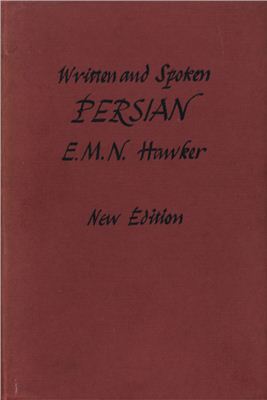Hawker E.M.N. Written and Spoken Persian. - Ldn. , N.Y. , Toronto:
Longmans, Green and Co, 1957. - 204p.
In this book the word lists are limited to such as can be frequently and usefully employed. The first part of the book contains none but the commonest words, and even in the third part very few purely literary words are used. Wherever such a word occurs a note is added to explain that it should not be used in conversation.
A definite attempt has been made at teaching useful sentences from the very beginning, even before all the letters have been leat. An exceptionally quick student may be irritated at not being taught all the alphabet in the first lesson, but the writer's experience is that a great deal of time is wasted by continual reference to an imperfectly leaed alphabet. The present system aims at making it impossible to forget any letter once leat. For those who dislike this method a loose-leaf alphabet is added.
Only such grammar as is necessary in speaking and writing the language is included. Outside this, points of grammatical interest are referred to in footnotes.
No set exercise should be omitted, as each has been arranged with a definite purpose.
It is hardly necessary to add that a student living in Iran will add many further words and idioms to his knowledge. Blank pages are added for these.
The Book is divided into 3 parts:
1. The Elements of the Language. Each lesson contains something absolutely necessary.
2. More Idiomatic Speech.
3. The Reading Book.This is for further practice and a very elementary introduction to Persian literature.
After finishing Part II the student is strongly recommended to read the second Reader of the Iranian Schools.
Pronunciation and Accent.
These can be well leat only from an Iranian teacher. If such is not available linguaphone records should be memorised.
Listen to Persian being spoken on every possible occasion. Roughly speaking, each syllable should be equally accented and the voice should not drop at the end of a sentence.
Unaccented syllables are pointed out in the book.
Punctuation is coming into use in Persian.
In this book the word lists are limited to such as can be frequently and usefully employed. The first part of the book contains none but the commonest words, and even in the third part very few purely literary words are used. Wherever such a word occurs a note is added to explain that it should not be used in conversation.
A definite attempt has been made at teaching useful sentences from the very beginning, even before all the letters have been leat. An exceptionally quick student may be irritated at not being taught all the alphabet in the first lesson, but the writer's experience is that a great deal of time is wasted by continual reference to an imperfectly leaed alphabet. The present system aims at making it impossible to forget any letter once leat. For those who dislike this method a loose-leaf alphabet is added.
Only such grammar as is necessary in speaking and writing the language is included. Outside this, points of grammatical interest are referred to in footnotes.
No set exercise should be omitted, as each has been arranged with a definite purpose.
It is hardly necessary to add that a student living in Iran will add many further words and idioms to his knowledge. Blank pages are added for these.
The Book is divided into 3 parts:
1. The Elements of the Language. Each lesson contains something absolutely necessary.
2. More Idiomatic Speech.
3. The Reading Book.This is for further practice and a very elementary introduction to Persian literature.
After finishing Part II the student is strongly recommended to read the second Reader of the Iranian Schools.
Pronunciation and Accent.
These can be well leat only from an Iranian teacher. If such is not available linguaphone records should be memorised.
Listen to Persian being spoken on every possible occasion. Roughly speaking, each syllable should be equally accented and the voice should not drop at the end of a sentence.
Unaccented syllables are pointed out in the book.
Punctuation is coming into use in Persian.

